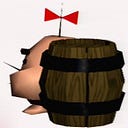An Ode to Radial Menus
Support my writing on Patreon or Ko-fi!
Menuing in videogames is an inevitability, but that doesn’t mean it can’t be enjoyable in its own right. In fact it’s well known that some games, even entire genres, are almost nothing but menuing. But when it comes to switching between menus and gameplay, there’s one shape that stands above all else: the circle.
Radial menus in games were first popularized by RPG’s like Secret of Mana and Lufia II and the need for quick item selection in battle. While still present in the RPG genre, radial menus really took off with “weapon wheels” of shooter games. Whether first person like Perfect Dark or third person like Ratchet & Clank, radial menus lend themselves to a distinct stop-start strategization gameplay loop.
Radial menus are not only visually appealing but highly kinetic and gestural in function. They’re equally suited to the rotational movement of an analog stick, the swiveling motion of a computer mouse, the swiping of a touchscreen or the pointing of a motion controller (I have a particular fondness for the item select menu of The Legend of Zelda: Twilight Princess on Wii). One does not scroll through a radial menu so much as you bounce around it, planning your next moves for when ammo runs out like mentally drawing out some pentagram-esque rune.
Radial menus are also often used in game-making software from modelling and animation programs to full-fledged 3D engines and level creators. So we see a feedback loop between front and back end via radial menus, especially within highly customizable game environments like Second Life and The Sims.
